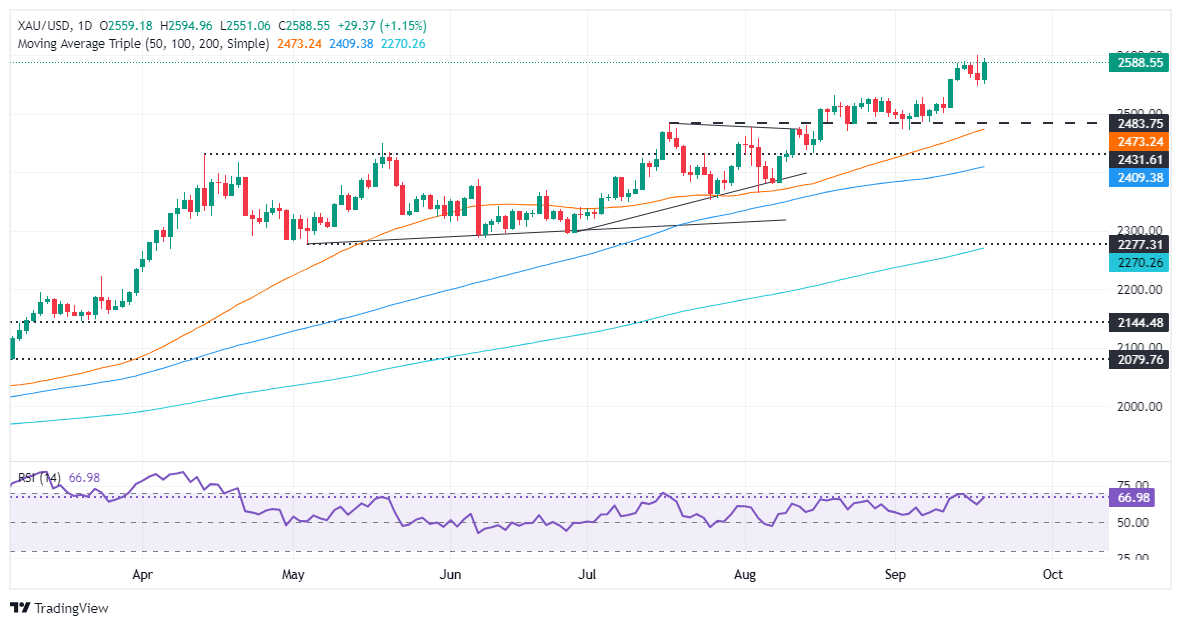- Gold prices surge following the Fed's 50 bps rate cut, with officials citing inflation moving toward the 2% target.
- Fed Chair Powell signals labor market strength and cautious policy adjustments, stating no rush to normalize rates.
- US jobs data shows resilience, while rising US Treasury yields fail to support the Greenback, as the DXY drops 0.31% to 100.62.
Gold prices advanced on Thursday after the Federal Reserve (Fed) embarked on an easing cycle with a 50-basis-point (bps) rate cut. Traders ignored the rise of US Treasury yields, which correlate inversely to the non-yielding metal, which remains on its way toward reclaiming $2,600. At the time of writing, XAU/USD trades at $2,589, up over 1%.
Following the Fed's decision, bullion prices extended their gains after registering losses on Wednesday. Officials side with the larger of two cuts expected by Wall Street, justifying their decision by pointing to inflation moving sustainably toward the Fed’s 2% goal. Fed Chair Jerome Powell stressed that the Fed could maintain labor strength with policy adjustments.
Powell commented that risks of inflation diminished, while the labor market had risen. Still he added that if inflation persists, “We can dial back policy more slowly,” while adding that according to the bank’s projections, it’s “not in a rush” to normalize policy.
In the meantime, the US jobs data is taking the spotlight after Powell’s speech at Jackson Hole, in which he shifted toward attaining the maximum employment mandate. On Thursday, the US Labor Department revealed that the number of people filing for unemployment benefits was below expectations, indicating strength in the labor market.
Meanwhile, US Treasury yields follow Gold’s footsteps, with the 10-year T-note yielding 3.74%, rising three and a half basis points. However, this has failed to underpin the Greenback, which, according to the US Dollar Index (DXY), dropped 0.31% to 100.62.
Ahead this week, Philadelphia Fed President Patrick Harker will cross the wires amid a scarce docket in the US.
Daily digest market movers: Gold price recovers amid betterstrong US jobs market data
- Fed Governor Michelle Bowman voted to lower rates by a quarter of a percentage point at the September FOMC meeting.
- The Summary of Economic Projections indicates the Fed projects interest rates to end at 4.4% in 2024 and 3.4% in 2025. Inflation, as measured by the Core Personal Consumption Expenditures Price Index, is estimated to reach its 2% target by 2026, with forecasts of 2.6% in 2024 and 2.2% in 2025.
- US economy will likely grow at a 2% pace in 2024, with the Unemployment Rate rising to 4.4% by the end of the year.
- US Initial Jobless Claims for the week ending September 14 dipped from 231K to 219K, below estimates of 230K.
- US Existing Home Sales plunged 2.5% MoM in August after dipping from 3.96 million to 3.86 million, declining for the fourth time in the year.
- December 2024 fed funds rate futures contracting suggests that the Fed might lower rates by at least 69 basis points, implying that in the following two meetings this year the market expects one 50 bps and one 25 bps rate.
XAU/USD technical outlook: Gold price buyers target $2,600 after Fed’s decision
Gold price uptrend remains intact, but after Wednesday’s Shooting Star candlestick pattern, buyers must challenge the year-to-date peak of $2,599 if they would like to stay hopeful of conquering the $2,600 mark.
Momentum favors buyers. The Relative Strength Index (RSI) aims upwards in bullish territory and not in overbought territory. Therefore, the path of least resistance is tilted to the upside.
XAU/USD's first resistance would be $2,599, followed by $2,600. On further strength, buyers can challenge the psychological levels of $2,650 and $2,700.
If XAU/USD drops below the September 13 low of $2,556, the next support would be $2,550. Once cleared, the next stop would be the August 20 high, which turned into support at $2,531, before aiming toward the September 6 low of $2,485.
Gold FAQs
Gold has played a key role in human’s history as it has been widely used as a store of value and medium of exchange. Currently, apart from its shine and usage for jewelry, the precious metal is widely seen as a safe-haven asset, meaning that it is considered a good investment during turbulent times. Gold is also widely seen as a hedge against inflation and against depreciating currencies as it doesn’t rely on any specific issuer or government.
Central banks are the biggest Gold holders. In their aim to support their currencies in turbulent times, central banks tend to diversify their reserves and buy Gold to improve the perceived strength of the economy and the currency. High Gold reserves can be a source of trust for a country’s solvency. Central banks added 1,136 tonnes of Gold worth around $70 billion to their reserves in 2022, according to data from the World Gold Council. This is the highest yearly purchase since records began. Central banks from emerging economies such as China, India and Turkey are quickly increasing their Gold reserves.
Gold has an inverse correlation with the US Dollar and US Treasuries, which are both major reserve and safe-haven assets. When the Dollar depreciates, Gold tends to rise, enabling investors and central banks to diversify their assets in turbulent times. Gold is also inversely correlated with risk assets. A rally in the stock market tends to weaken Gold price, while sell-offs in riskier markets tend to favor the precious metal.
The price can move due to a wide range of factors. Geopolitical instability or fears of a deep recession can quickly make Gold price escalate due to its safe-haven status. As a yield-less asset, Gold tends to rise with lower interest rates, while higher cost of money usually weighs down on the yellow metal. Still, most moves depend on how the US Dollar (USD) behaves as the asset is priced in dollars (XAU/USD). A strong Dollar tends to keep the price of Gold controlled, whereas a weaker Dollar is likely to push Gold prices up.
Information on these pages contains forward-looking statements that involve risks and uncertainties. Markets and instruments profiled on this page are for informational purposes only and should not in any way come across as a recommendation to buy or sell in these assets. You should do your own thorough research before making any investment decisions. FXStreet does not in any way guarantee that this information is free from mistakes, errors, or material misstatements. It also does not guarantee that this information is of a timely nature. Investing in Open Markets involves a great deal of risk, including the loss of all or a portion of your investment, as well as emotional distress. All risks, losses and costs associated with investing, including total loss of principal, are your responsibility. The views and opinions expressed in this article are those of the authors and do not necessarily reflect the official policy or position of FXStreet nor its advertisers. The author will not be held responsible for information that is found at the end of links posted on this page.
If not otherwise explicitly mentioned in the body of the article, at the time of writing, the author has no position in any stock mentioned in this article and no business relationship with any company mentioned. The author has not received compensation for writing this article, other than from FXStreet.
FXStreet and the author do not provide personalized recommendations. The author makes no representations as to the accuracy, completeness, or suitability of this information. FXStreet and the author will not be liable for any errors, omissions or any losses, injuries or damages arising from this information and its display or use. Errors and omissions excepted.
The author and FXStreet are not registered investment advisors and nothing in this article is intended to be investment advice.
Recommended content
Editors’ Picks

US PCE rose 2.5% YoY in February, matching consensus – LIVE
According to the US Department of Commerce, the annual headline PCE inflation rate in February was 2.5%, while core PCE inflation—which excludes food and energy—came in higher at 2.8%.

Gold keeps its bid bias intact, targets $3,100
Gold remains well bid around the $3,080 zone per troy ounce after US inflation figures met expectations in February, while US yields maintain a bearish stance across the curve.

EUR/USD remains offered below 1.0800 post-US PCE
The US Dollar resumes its upside impulse on Friday, keeping EUR/USD under pressure and still below the key 1.0800 barrier after the release of February’s PCE inflation readings.

Donald Trump’s tariff policies set to increase market uncertainty and risk-off sentiment
US President Donald Trump’s tariff policies are expected to escalate market uncertainty and risk-off sentiment, with the Kobeissi Letter’s post on X this week cautioning that while markets may view the April 2 tariffs as the "end of uncertainty," it anticipates increased volatility.

US: Trump's 'Liberation day' – What to expect?
Trump has so far enacted tariff changes that have lifted the trade-weighted average tariff rate on all US imports by around 5.5-6.0%-points. While re-rerouting of trade will decrease the effectiveness of tariffs over time, the current level is already close to the highest since the second world war.

The Best brokers to trade EUR/USD
SPONSORED Discover the top brokers for trading EUR/USD in 2025. Our list features brokers with competitive spreads, fast execution, and powerful platforms. Whether you're a beginner or an expert, find the right partner to navigate the dynamic Forex market.
